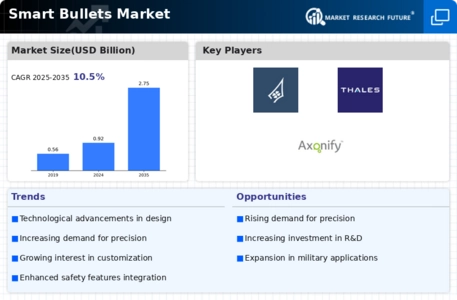Market Share
Smart Bullets Market Share Analysis
Developments in technology, precision warfare, and military accuracy need are driving the Smart Bullets industry. Guided smart bullets are a trend. Guidance systems, sensors, and targeting technologies are improving traditional munitions to accurately hit targets mid-flight. This tendency supports the military's focus on limiting collateral damage and pinpointing in various tactical circumstances, improving small arms performance.
Integration of smart technology for situational awareness is another Smart Bullets industry development. Real-time data from smart bullets with sensors and networking capabilities helps shooters make smarter tactical decisions. These technologies give soldiers real-time input on wind, target movement, and distance, boosting their awareness and accuracy. This development reflects military attempts to equip soldiers with superior tactical decision-making capabilities.
Additionally, sniper rifle smart bullet technologies are becoming popular. Smart bullet sniper systems improve accuracy and precision at long ranges. Even under difficult situations, fire control devices, laser rangefinders, and guided bullets help snipers engage targets. This development matches present military needs for snipers in long-range precise engagements.
In the Smart Bullets market, pricing and accessibility are rising. Manufacturers are developing cost-effective smart bullet options for military use as technology progresses. This trend provides scalable and economical smart bullet choices so more military units may benefit from guided and smart gunfire.
Research and development on next-generation smart bullet technologies is also rising. Improved guiding, materials, and moving target engagement are innovations. Technology is constantly improving smart bullet performance, making them more useful in complicated surroundings and operating circumstances.
In the Smart Bullets industry, AI and ML integration is growing. Smart bullets use AI and ML algorithms to assess data in real time, adapt to changing situations, and increase aiming accuracy. This tendency follows the emergence of smart weapon systems, which improve military assets through autonomous and learning capabilities.
Smart bullet development is also trending toward multinational cooperation. Countries and defense contractors are partnering to develop sophisticated smart bullet technology. This collaborative approach promotes information sharing and standardization, advancing smart bullet capabilities worldwide.

















Leave a Comment